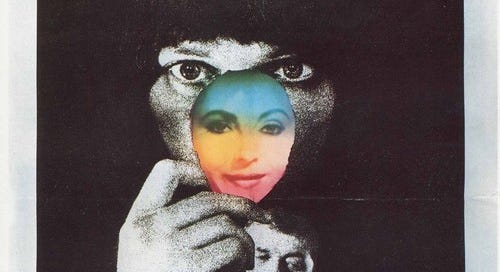The Discerning Lesbian's Starter Guide to Classic Cinema (Part Two)
From Bacall to Blood and Roses - for beginners
French poster for Secret Ceremony. Why are the French so good at posters?
This is my second vaguely chronological list of lesbian film recommendations for film history beginners. This time, we’re going to travel from 1950 to 1971, encountering more European influence on Hollywood (and vice versa), more boarding schools, more vampires, and some oddballs. Let me know if I missed anything!
Young Man with a Horn (1950)
What? Underrated biopic of a trumpeter and his (wait for it) bisexual girlfriend.
Who? Lauren Bacall plays the best character in anything ever, and she does it really well. She deserves more female fans! Michael Curtiz appropriates the classic film noir style with an expert hand.
Why? Literally just for Lauren Bacall, who first appears 40ish minutes in, but the rest of the film is good too. Her bisexuality is communicated through mirrors and monologues. It is all very clever. Camille Paglia likes this film and has mentioned it in Sexual Personae, claiming that Bacall’s character is a non-literal example of the lesbian vampire archetype.
If you liked this, try… The Earrings of Madame De… by Max Ophüls for more of an idea of the cinematic language of mirrors and where it might have come from; The Big Sleep for an actual noir with even more Bacall. Or How to Marry a Millionaire to see her doing comedy. Also if you liked Curtiz’s directorial style, his proto-feminist Mildred Pierce is a must-see.
Olivia (1951)
What? A Maedchen in Uniform-esque tale set in an opulent French school. A young English girl wrestles with the affections of two headmistresses.
Who? Edwige Feuillere. Watch it and you’ll see. Also - landmark female director, Jacqueline Audry.
Why? The cinematography is gorgeous and sensual (moving cameras, gilt, flowers, more mirrors) and the change of setting raises interesting moral questions which did not appear in its predecessor. A double bill with the 1931 Maedchen is worth it - the subtler differences (the books the girls read, for example - from Bible stories to Racine) are deliberate and clever.
If you liked this, try… Also anything by Max Ophüls, for more cool camera motions and mirrors (Audry studied under this director). And its Spanish contemporary, Muchachas de Uniforme - once locked in a vault but now newly available online.
Maedchen in Uniform (1958)
What? A clinical colour remake of the 1931 film. It’s not as good but it’s still worth a watch.
Who? Romy Schneider is a fantastic actress and has never done anything wrong ever. Lilli Palmer is no Dorothea Wieck but she’s OK I guess.
Why? It’s fascinating to see the same story adapted to the same medium in two different Germanies - the Babylonic Weimar Germany and the post-war, post-Nazi Germany. This one is also more accurate to the original novel.
If you liked this, try… Romy Schneider in Sissi just because she’s so good at acting. The House that Screamed is a Spanish horror film also starring Lilli Palmer as, strangely enough, the head of a girls’ boarding school. And for the big, probably totally accurate story of postwar Germany and its treatment of women, try Fassbinder’s The Marriage of Maria Braun. When I come to think of it, this film - with its detached portrayal of controversial desire - reminds me a lot of Fassbinder as a director.
Secret Ceremony (1968)
What? Hysterical Freudian fever dream about a London prostitute and the strange girl who is obsessed with her.
Who? Elizabeth Taylor and Mia Farrow are there, and their performances are both ridiculous. Masterminded by my personal favourite director, Brecht protégé Joseph Losey. Camille Paglia loves this film and has written very touchingly about its early impact on her worldview.
Why? This never gets recommended as a lesbian film (or it just doesn’t get recommended, full stop). I am about to break with this tradition. It’s a masterpiece of quotable, mildly traumatising dramatic bizarrity - if you like Mommie Dearest, and if you have all the relevant personal issues, you will love this. The sets are gorgeous too. So much Art Nouveau!
If you liked this, try… Joseph Losey’s serious gay masterpiece, The Servant; Liz Taylor’s other mad subtextual romp, X Y and Z, and her best film, Suddenly Last Summer.
Daughters of Darkness (1971)
What? A stylish, gentle(ish) horror about genteel lesbian vampire Elisabeth Bathory.
Who? Delphine Seyrig is a sparkly Bathory with Dietrich sensibilities. She’s so amazing that it’s hard to focus on anyone else. Françoise Hardy (no, not that one, except for some reason I thought it was that one?) does the sets and I love her for it.
Why? A standout of the 60s-70s lesbian vampire explosion, this is the smartest and dreamiest film of its genre. The art direction is gorgeous and contains allusions to other lesbian cinema outings, so it’s a great one to watch when you’ve finished others on this list! I personally did not think it was marred by the male gaze, and found myself relating to it all the way through (but maybe I should be worried about this).
If you liked this, try… Roger Vadim’s Eurotrashy Blood and Roses, or Jesus Franco’s even Eurotrashier Vampyros Lesbos. Neither are fantastic on the ‘male gaze’ front, but exploitation is as exploitation does. (Also the soundtrack to Vampyros Lesbos is my current writing music)
Again - if you’d like to talk about your own lesbian classic cinema experience, feel free to get in touch to be in my next article!










